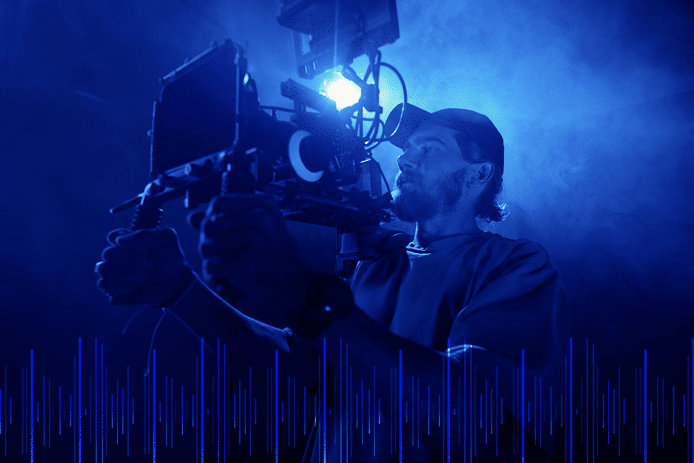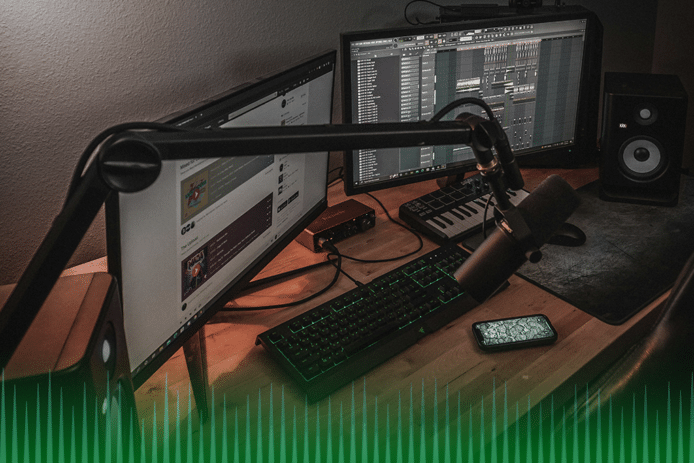Sonix is an automated transcription service. We transcribe audio and video files for storytellers all over the world. We are not associated with the Set Sail podcast. Making transcripts available for listeners and those that are hearing-impaired is just something we like to do. If you are interested in automated transcription, click here for 30 free minutes.
To listen and watch the transcript playback in real-time ?, just click the player below.
Full Transcript by Sonix: Best Interview Microphones – Set Sail Podcast
Ross: Hey and welcome to Episode 11 of the Set Sail podcast. My name is Ross. And today we are going to be talking about interview microphones.
Ross: And what that means is there’s kind of different kinds of handheld there is shotgun microphones that are typically used in like a video kind of a talking head type of shot. There’s lavalier microphones.
Ross: So will highlight some of the different options mostly focused on the handheld type but we’ll go through all of them for you and you will know what the best interview microphones are for your podcast probably but for lots purposes if you want to create YouTube videos or just other marketing material where you need to record great audio.
Ross: These are awesome options. So there’s a few different there’s lots of different ways to record interviews so you can be outside or inside. You can be sitting standing you can be spur of the moment you’ll be walking around at a conference like Podcast Movement and you know just need to get it quick quick thought or interview of someone that you see.
Ross: That would require different gear then something whereas you know you’re sitting down and you have it all set up. So just just something to think about. It’s different equipment for different different uses. And that kind of makes all all the difference. So we’re gonna start with those handheld interview microphones and this kind of things you see on TV a lot of reporters will use.
Ross: So let’s get into it. There’s a number. There’s different kinds so there’s different kinds of pickup patterns there’s omni-directional so it picks up from all sides. And that that makes it easier for someone to not be in like the exact perfect position while they’re interviewing someone.
Ross: But they are more susceptible to picking up background noise. So you have to be a little more careful there. There’s also dynamic hand-held interview microphones and those are great because.
Ross: I’m comparing two different things but there’s there’s no dynamic mics and they don’t need a battery or Fensom power which is which is nice. You don’t have to worry about those running out. And then going back step here there’s also cardiod directional pickup patterns. So those you’ll have to make sure are pointed right at someone’s mouth when you’re your recording or interviewing.
Ross: And then you’ll need to make sure you know if you have one microphone really makes the point back at your mouth when you’re talking. So there can be some they drop off easily if you’re not pointing them in the exact right spot. But they’re less they’re less susceptible to picking up that that background sound so just some some trade-offs there.
Ross: Now we can go into some of the options here. The first one is the Rode Reporter. Got a nice long long handle. It’s an omni directional dynamic mic. And it includes a mic flag so you can put your brand or podcast right on it. It’s kind of cool. So it was a non reflective matte finish so it won’t be really distracting on camera I don’t pick up a lot of that glare.
Ross: Which is actually really important because you want people to be focused on the message or the person maybe you’re interviewing and not not a microphone that’s like blinding them so little little things to think about if your going to be on camera that might not be so obvious.
Ross: Another popular one here is the Electro-Voice RE50/B. And it is an omni directional dynamic mic as well. It has an internal shock mount. It’s very durable. And they also have another model with the RE50 ND. And it’s a little more sensitive so it has a higher higher output level there. Uses different different magnets inside of it.
Ross: Next is the Sennheiser MD46 and this one is a cardiod dynamic mic. So it has that directional pickup pattern. And it does really well for reducing all that background sound. It has really low handling noise. It’s made all metal. And has a double layered grill to prevent plosives and you know those kind of sharp air sound go from sneaking into the microphone element. So that’s pretty nice there.
Ross: A popular one also is the Beyerdynamic M58. It’s an omni directional dynamic mic. Nice long handle.
Ross: Electro-voice 635NDB is another omni directional mic. It uses a neo dimium might a might have butchered that magnet for higher output levels. And this mic is designed for high humidity and extreme temperatures. So it’s really good for interviewing outdoors because microphones can be really susceptible to either messing up or just completely failing in some of those more extreme conditions.
Ross: Imagine you’re out interviewing someone in a hurricane or something. Or just even even parts of the country or world that just have high high humidity or high no real high or low temperatures not great for microphones. So getting something that can handle those is important. Something to think about ahead of time.
Ross: And here’s another cool one. It is a real long handled microphone. So great to be able to reach those basketball players that you’re interviewing or just someone where you want to give them a little space. It’s the Audio-technica AT8004L. L is for that long handle. It’s nine, basically nine and a half inches long and has an omni directional pick up pattern. And yeah usually runs are just over a hundred dollars for that. It’s a nice balance of price and quality I think.
Ross: Another one is the Shure VP64A. And it’s a great value. Under 100 dollars. It’s omni directional dynamic. That neodymium magnet. And has a water resistant grill which is nice nice touch as well. So that’s kind of the rundown of the handheld interview mics.
Ross: And be sure to go to Setsailpodcast.com/11 to see pictures of these and links to go pick one up for yourself if you are going to be doing lots of interviewing and want something like that and you’ll also see the rest of the day mics I’m about to mention. So Setsailpodcast.com/11.
Ross: Next we have the hand-held interview mic accessories. So these are kind of add ons or ways to make them be used with different different devices.
Ross: The first is the Rodelink NewsShooter Kit. And it basically turns your XLR microphone into a wireless version. So it has a little receiver or transmitter. One of those sticks into the bottom of the mic and then you pair it with another piece and that that piece can be connected into a digital audio recorder.
Ross: It can be hooked into a DSLR or basically any video camera. Or it can be hooked into a field recorder. Basically any any system you can kind of make it wireless. So it’s really cool and highly recommendeded way to just make things much easier on you if you’re going to be doing a lot of interviewing.
Ross: Another cool accessory from Rode is the IXLR. So it plugs in to the interview mics just like just like the NewsShooter Kit. But it has a lightning connection on the other end so it’s meant to be used with an iPhone. And it has a couple different options. It has headphone jack for monitoring.
Ross: It has a headphone volume control. It even has a pad switch so that will lower the input by 20 decibels and yeah kind of all the conversion stuff to make your iPhone a mobile digital audio recorder which is really cool.
Ross: So it’s highly recommend. It’s not cheap. I think it’s around 150 dollars if I remember correctly. Yep. But you know if you have plenty of space on your phone or you know what you have on you. So you only need one. You know one small little accessory and a microphone and you can you can record anything you want which is which is awesome.
Ross: So avoid little note here avoid the kind of cheaper XLR to mini jack converters because they they just don’t work. Just to just sort of keep it keep it at that. You want something that does the the conversion in a proper way. So check that out if that sounds cool.
Ross: Another couple options here. Now we’re moving on to some different types of microphones and specifically Shotgun interview microphones.
Ross: And these are these are used on camera a lot. So there’s the first one is the Sennheiser MKH416. And this microphone is widely used in professional film broadcast settings. And it’s really meant to excel in noisier environments but it reduces all that extra noise because it’s directional points. You know it it just records what it’s pointing at for the most part.
Ross: It’s not not cheap. For sure it’s see it’s about a thousand dollars. But you know you pay for you pay for quality. So check that out.
Ross: Another cheaper option is the Rode NTG4 Plus. I like I really like this one Rode Rode seems to come up a lot in this topic. And let me look up the price on this one real quick. It runs four hundred dollars. But really cool it has some buttons right on it so you can control some cutoff levels and high pass filter pad. Some of that stuff right on on top of it.
Ross: It’s not it’s not too big. It’s kind of a good a good balance in size. And the the buttons are kind of indented so you won’t accidentally press them too. The battery last for a long time. I don’t know I think it looks cool. So that would be would be a good option I think for kind of a starter shotgun mic. Maybe maybe not the cheapest starter option but it’s not not the most expensive either.
Ross: And this one is not technically a shotgun mic it’s a hyper cardiod microphone. It’s the Audio-Technica 804053B. And I really like this one so I shotgun mics tend to sound echo-y or boom-y when used indoors and kind of places with lots of lots of reflection. So these hyper cardoid microphones are directional and they don’t they don’t really pick up all that. Those sound waves bouncing off off the walls so they’re perfect to use indoors.
Ross: And this Audio-Technica 804053. It comes with a hyper cardoid capsule. But you can actually change it to give the purchase purchase them separately. But you can change it to cardiod or omni directional so you gonna get some nice flexibility of pickup patterns depending on depending on what you’re doing what your space is like.
Ross: So I like the flexibility. This one I pull it up for you. It is 600 dollars so not not cheap but definitely definitely kind of an industry standard it’s excellent for recording voice and that’s what it’s designed for.
Ross: It has a 80 Hertz hipass filter a 10 decibel pad. It’s yeah it’s a great option for now to kind of sit down sit down interviews where you know you’ll have it mounted to something. So if you have something planned it’s an awesome awesome option.
Ross: We have some more accessories I listed a stand actually I have it sitting sitting right next to me here. It’s called the Gator Framework’s Tripod microphone stand with boom arm. So it has a removable turn over here and look at it is removable boom arm. You can use it handheld if you want. You can use it with a tripod.
Ross: I actually have a studio mic hooked up to it. And it’s awesome has a ton of little kind of secure latch points. It has mic routing clips kind of red tipped feet so people see it don’t trip over it which definitely happens. So there a little little touches really add up to make it a really high quality stand.
Ross: And you might need to get some sandbags to kind of put on the feet if you use some heavier microphones because it can it can tip over a Rode NT1 hooked up to it. And if it’s if it’s standing up too high it will get top heavy. So just a thought there was spill my coffee.
Ross: Next is kind of a hand-held pistol grip. So it’s the Rode PG2-R and just so you know shotgun mics are really susceptible to handling noise. So you want them you don’t want to hold them in your hand you want them to be attached to a shock mount so that they only pick up what they’re supposed to pick up.
Ross: And this is an awesome accessory. You just kind of clip your shotgun mic in there and you can attach you to hold it in your hand or you can attach it to a boom pole like I mentioned before. Those two options are are endless as far as as far as that goes. And then if you’re outside or you’re going to be moving the microphone around or you have an like someone who’s going to move for you. You are going to want a windscreen.
Ross: So I list a couple as Rode makes a couple of high quality ones here. The WS6 and WS7 for different lengths of Shotgun mics. And they also make the Rode Blimp which is a is a pistol grip. And like a big enclosing thing you’ve probably see him all the time in a professional level recording because they really reduce that that movement wind sound all that stuff.
Ross: So you’ll even see them on like racetracks things like that where there’s a lot of a lot of wind. So not cheap. Let me look this one up. This is 300 dollars for the kit. But high quality. It will last and it’ll keep that wind any sound you don’t want it’ll keep it out. So worth it if you’re doing a lot of that.
Ross: And then I have some other other options some on camera shotgun mics that are great for a run and gun video recording. But you can also what’s really cool is you can you can mount them separately to a to a boom pole. If you’re doing kind of a sit down interview mics.
Ross: So you can get the instead of mounting the microphone to your camera you can mount it to boom pull closer to your subject just out of the frame and you’ll you’ll just needed an extension cable to plug into your camera or to an audio recorder or something like that.
Ross: And it can be used as a boom. Kind of a separate boom mic so I like the flexibility of these so-called on camera shotgun mics but they can be used off camera as well.
Ross: So that the newest one they just came out a few months ago I think is the Rode VideoMic Pro Plus. This is their best model. They kind of tweaked a lot of things. It uses a rechargeable battery but you can also put in AA batteries. It has a safety track so it will record a different level that’s that’s lower in case you someone clips which is really nice.
Ross: It has auto power on and off. Controls are easy to access. It’s it’s awesome. It’s 300 dollars so not cheap. But the versatility and the functionality really makes it just top notch.
Ross: And kind of the closest competitor to that is the Shure VP83F Lenshopper. And this one can be used without a camera or an audio recorder because it has a micro SD card so you can actually use it separately which is pretty cool.
Ross: And it has a really fine gain control in one decibel increments so you can you can nail down the perfect levels that you need which is awesome as well. So those are the kind of two best options there.
Ross: And then we’re going to move down to lavalier mics. There’s a ton of these. So just kind of run through them.
Ross: Sony ECM77B is really popular. Industry standard mic for interviewing connects with an XLR cable. And can use AA batteries or phantom power for that omni directional condenser mic.
Ross: The Rode Smartlab is a headphone jack plugs a TRRS. And it’s meant to be used with a smartphone even though most of those are losing their headphone jacks. You can always use the adapters into the lightning to headphone adapter or whatever phone you have. Usually comes with those.
Ross: Or you can even get an adapter from that size the TRRS headphone jack into a TRS jack which is used in other devices like cameras and audio recorders. So just because it’s meant for smartphone doesn’t mean you can’t use it with other devices.
Ross: And then a cheaper one. And I actually like this one. It’s about 30 dollars. The Audio-Technica ATR3350IS. And it comes with a little adapter so you can use it with a smartphone or with an audio recorder. It let’s you use both sides. It uses a battery so you’ll you’ll probably want to pick up some extra extra batteries when you if you get this.
Ross: It comes the clip. I think that sounds sounds pretty good for a 30 dollar lavalier mic. Lots of functionality flexibility so pretty cool I know a lot of people who just pick up like 3 or 4 of these just to have have backups.
Ross: And then rounding out the options here is kind of similar to what I mentioned before. It’s the Rodelink Filmmaker kit instead of the NewsShooter kit. And this one comes the lavalier microphone instead of the connection that goes into that interview microphone. So basically the same idea you can plug it into camera audio recorder or a field recorder. Something like that.
Ross: And then someone will have a little a little belt clip that the lavalier microphone goes into. And so you’ll have someone who can be recorded wirelessly. Awesome awesome little kit for four hundred dollars. I think the microphone itself normally runs almost that much so I think that’s one of the best values and kind of the wireless lavalier mic world.
Ross: I highly recommend those those kits and you can you can get a couple of them too if you want. You just need to make sure you have no one receiver and one transmitter. They go together. So if you get two devices you’ll need two transmitters and two receivers.
Ross: So that rounds out our interview microphone’s couple options are there maybe maybe more than a couple but hopefully that was useful to you. And do you want to check out more details. Be sure to go to Setsailpodcast.com/11 and you’ll be able to check all these out.
Ross: And lastly if you haven’t done so already I would love if you would leave a rating in review on iTunes or whatever you listen to this podcast and other podcasts. So it will be awesome it’ll help us reach more people get more visibility and I will get the feedback is very useful as well. And if you leave your name and maybe your podcast or website I can give you a shout out in a future episode. So I will thank you. Thank you in advance for that and all I’ll see you in episode 12.
New to Sonix? Click here for 30 free transcription minutes!
World's Most Accurate AI Transcription
Sonix transcribes your audio and video in minutes — with accuracy that'll make you forget it's automated.
Keep reading
More articles you might find helpful




